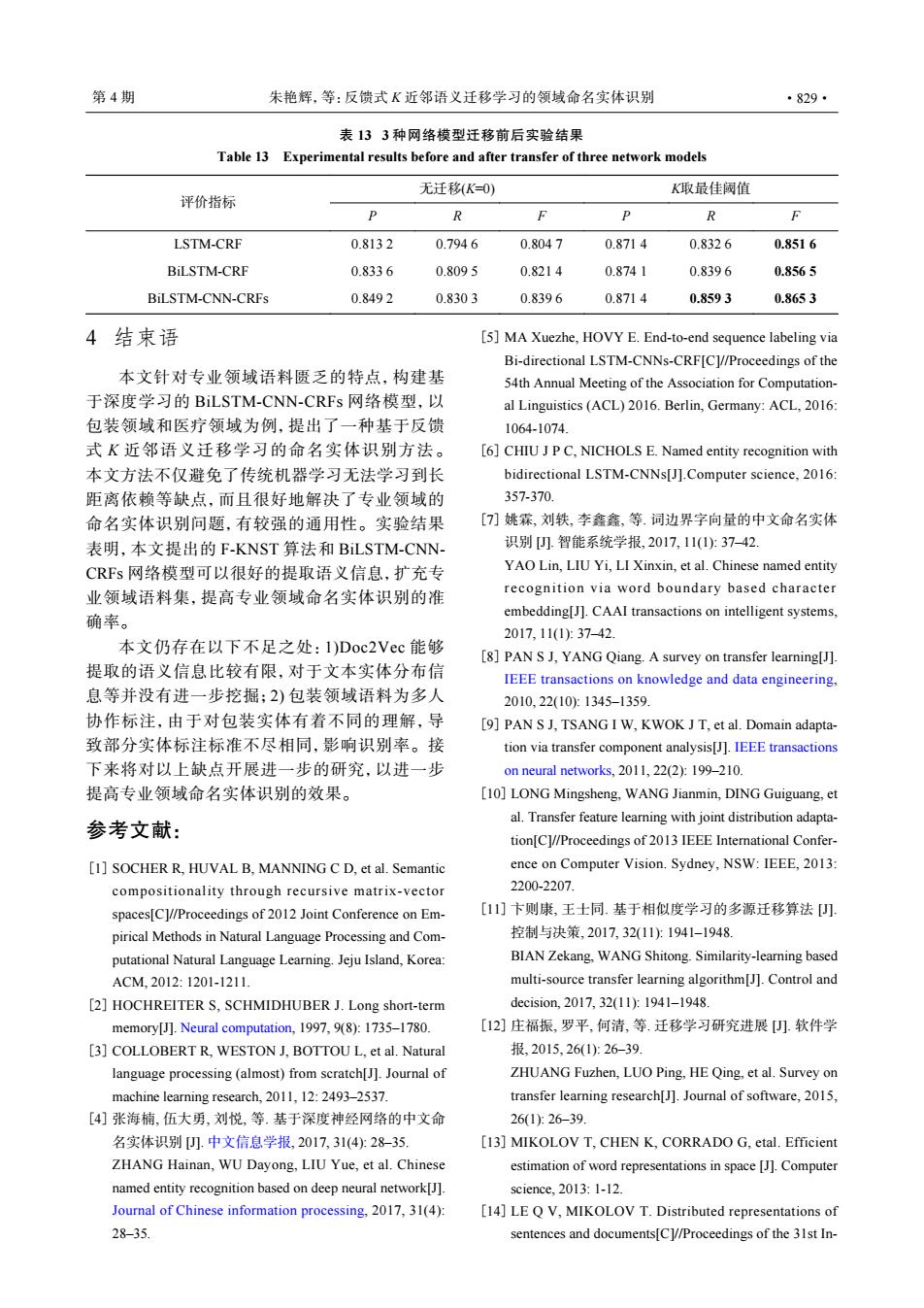正在加载图片...

第4期 朱艳辉,等:反馈式K近邻语义迁移学习的领域命名实体识别 ·829· 表133种网络模型迁移前后实验结果 Table 13 Experimental results before and after transfer of three network models 无迁移K=0) K取最佳阈值 评价指标 P R F P R F LSTM-CRF 0.8132 0.7946 0.8047 0.8714 0.8326 0.8516 BiLSTM-CRF 0.8336 0.8095 0.8214 0.8741 0.8396 0.8565 BiLSTM-CNN-CRFs 0.8492 0.8303 0.8396 0.8714 0.8593 0.8653 4结束语 [5]MA Xuezhe,HOVY E.End-to-end sequence labeling via Bi-directional LSTM-CNNs-CRF[C]//Proceedings of the 本文针对专业领域语料匮乏的特点,构建基 54th Annual Meeting of the Association for Computation- 于深度学习的BiLSTM-CNN-CRFs网络模型,以 al Linguistics (ACL)2016.Berlin,Germany:ACL,2016: 包装领域和医疗领域为例,提出了一种基于反馈 1064-1074. 式K近邻语义迁移学习的命名实体识别方法。 [6]CHIU J P C,NICHOLS E.Named entity recognition with 本文方法不仅避免了传统机器学习无法学习到长 bidirectional LSTM-CNNs[J].Computer science,2016: 距离依赖等缺点,而且很好地解决了专业领域的 357-370. 命名实体识别问题,有较强的通用性。实验结果 [7]姚霖,刘轶,李鑫鑫,等.词边界字向量的中文命名实体 表明,本文提出的F-KNST算法和BiLSTM-CNN- 识别.智能系统学报,2017,11(1)少:37-42. CRFs网络模型可以很好的提取语义信息,扩充专 YAO Lin,LIU Yi,LI Xinxin,et al.Chinese named entity 业领域语料集,提高专业领域命名实体识别的准 recognition via word boundary based character embedding[J].CAAI transactions on intelligent systems, 确率。 2017,11(1):37-42. 本文仍存在以下不足之处:I)Doc2Vec能够 [8]PAN S J,YANG Qiang.A survey on transfer learning[J]. 提取的语义信息比较有限,对于文本实体分布信 IEEE transactions on knowledge and data engineering, 息等并没有进一步挖掘;2)包装领域语料为多人 2010,22(10:1345-1359 协作标注,由于对包装实体有着不同的理解,导 [9]PAN S J.TSANG I W,KWOK J T.et al.Domain adapta- 致部分实体标注标准不尽相同,影响识别率。接 tion via transfer component analysis[J].IEEE transactions 下来将对以上缺点开展进一步的研究,以进一步 on neural networks,2011,22(2):199-210. 提高专业领域命名实体识别的效果。 [10]LONG Mingsheng,WANG Jianmin,DING Guiguang,et al.Transfer feature learning with joint distribution adapta- 参考文献: tion[Cl//Proceedings of 2013 IEEE International Confer- [1]SOCHER R.HUVAL B,MANNING C D,et al.Semantic ence on Computer Vision.Sydney,NSW:IEEE,2013: compositionality through recursive matrix-vector 2200-2207. spaces[C]//Proceedings of 2012 Joint Conference on Em- [11]卞则康,王土同.基于相似度学习的多源迁移算法 pirical Methods in Natural Language Processing and Com- 控制与决策,2017,32(11):1941-1948. putational Natural Language Learning.Jeju Island,Korea: BIAN Zekang,WANG Shitong.Similarity-learning based ACM,2012:1201-1211. multi-source transfer learning algorithm[J].Control and [2]HOCHREITER S,SCHMIDHUBER J.Long short-term decision,2017,32(11:1941-1948. memory[J].Neural computation,1997,9(8):1735-1780. [12]庄福振,罗平,何清,等.迁移学习研究进展[】.软件学 [3]COLLOBERT R.WESTON J.BOTTOU L.et al.Natural 报,2015,26(1)26-39. language processing (almost)from scratch[J].Journal of ZHUANG Fuzhen,LUO Ping,HE Qing,et al.Survey on machine learning research,2011,12:2493-2537. transfer learning research[J].Journal of software,2015, [4]张海楠,伍大勇,刘悦,等.基于深度神经网络的中文命 26(126-39. 名实体识别).中文信息学报,2017,31(4):28-35. [13]MIKOLOV T,CHEN K,CORRADO G,etal.Efficient ZHANG Hainan,WU Dayong,LIU Yue,et al.Chinese estimation of word representations in space [J.Computer named entity recognition based on deep neural network[J]. science,2013:1-12. Journal of Chinese information processing,2017,31(4): [14]LE Q V,MIKOLOV T.Distributed representations of 28-35. sentences and documents[Cl//Proceedings of the 31st In-4 结束语 本文针对专业领域语料匮乏的特点,构建基 于深度学习的 BiLSTM-CNN-CRFs 网络模型,以 包装领域和医疗领域为例,提出了一种基于反馈 式 K 近邻语义迁移学习的命名实体识别方法。 本文方法不仅避免了传统机器学习无法学习到长 距离依赖等缺点,而且很好地解决了专业领域的 命名实体识别问题,有较强的通用性。实验结果 表明,本文提出的 F-KNST 算法和 BiLSTM-CNNCRFs 网络模型可以很好的提取语义信息,扩充专 业领域语料集,提高专业领域命名实体识别的准 确率。 本文仍存在以下不足之处:1)Doc2Vec 能够 提取的语义信息比较有限,对于文本实体分布信 息等并没有进一步挖掘;2) 包装领域语料为多人 协作标注,由于对包装实体有着不同的理解,导 致部分实体标注标准不尽相同,影响识别率。接 下来将对以上缺点开展进一步的研究,以进一步 提高专业领域命名实体识别的效果。 参考文献: SOCHER R, HUVAL B, MANNING C D, et al. Semantic compositionality through recursive matrix-vector spaces[C]//Proceedings of 2012 Joint Conference on Empirical Methods in Natural Language Processing and Computational Natural Language Learning. Jeju Island, Korea: ACM, 2012: 1201-1211. [1] HOCHREITER S, SCHMIDHUBER J. Long short-term memory[J]. Neural computation, 1997, 9(8): 1735–1780. [2] COLLOBERT R, WESTON J, BOTTOU L, et al. Natural language processing (almost) from scratch[J]. Journal of machine learning research, 2011, 12: 2493–2537. [3] 张海楠, 伍大勇, 刘悦, 等. 基于深度神经网络的中文命 名实体识别 [J]. 中文信息学报, 2017, 31(4): 28–35. ZHANG Hainan, WU Dayong, LIU Yue, et al. Chinese named entity recognition based on deep neural network[J]. Journal of Chinese information processing, 2017, 31(4): 28–35. [4] MA Xuezhe, HOVY E. End-to-end sequence labeling via Bi-directional LSTM-CNNs-CRF[C]//Proceedings of the 54th Annual Meeting of the Association for Computational Linguistics (ACL) 2016. Berlin, Germany: ACL, 2016: 1064-1074. [5] CHIU J P C, NICHOLS E. Named entity recognition with bidirectional LSTM-CNNs[J].Computer science, 2016: 357-370. [6] 姚霖, 刘轶, 李鑫鑫, 等. 词边界字向量的中文命名实体 识别 [J]. 智能系统学报, 2017, 11(1): 37–42. YAO Lin, LIU Yi, LI Xinxin, et al. Chinese named entity recognition via word boundary based character embedding[J]. CAAI transactions on intelligent systems, 2017, 11(1): 37–42. [7] PAN S J, YANG Qiang. A survey on transfer learning[J]. IEEE transactions on knowledge and data engineering, 2010, 22(10): 1345–1359. [8] PAN S J, TSANG I W, KWOK J T, et al. Domain adaptation via transfer component analysis[J]. IEEE transactions on neural networks, 2011, 22(2): 199–210. [9] LONG Mingsheng, WANG Jianmin, DING Guiguang, et al. Transfer feature learning with joint distribution adaptation[C]//Proceedings of 2013 IEEE International Conference on Computer Vision. Sydney, NSW: IEEE, 2013: 2200-2207. [10] 卞则康, 王士同. 基于相似度学习的多源迁移算法 [J]. 控制与决策, 2017, 32(11): 1941–1948. BIAN Zekang, WANG Shitong. Similarity-learning based multi-source transfer learning algorithm[J]. Control and decision, 2017, 32(11): 1941–1948. [11] 庄福振, 罗平, 何清, 等. 迁移学习研究进展 [J]. 软件学 报, 2015, 26(1): 26–39. ZHUANG Fuzhen, LUO Ping, HE Qing, et al. Survey on transfer learning research[J]. Journal of software, 2015, 26(1): 26–39. [12] MIKOLOV T, CHEN K, CORRADO G, etal. Efficient estimation of word representations in space [J]. Computer science, 2013: 1-12. [13] LE Q V, MIKOLOV T. Distributed representations of sentences and documents[C]//Proceedings of the 31st In- [14] 表 13 3 种网络模型迁移前后实验结果 Table 13 Experimental results before and after transfer of three network models 评价指标 无迁移(K=0) K取最佳阈值 P R F P R F LSTM-CRF 0.813 2 0.794 6 0.804 7 0.871 4 0.832 6 0.851 6 BiLSTM-CRF 0.833 6 0.809 5 0.821 4 0.874 1 0.839 6 0.856 5 BiLSTM-CNN-CRFs 0.849 2 0.830 3 0.839 6 0.871 4 0.859 3 0.865 3 第 4 期 朱艳辉,等:反馈式 K 近邻语义迁移学习的领域命名实体识别 ·829·